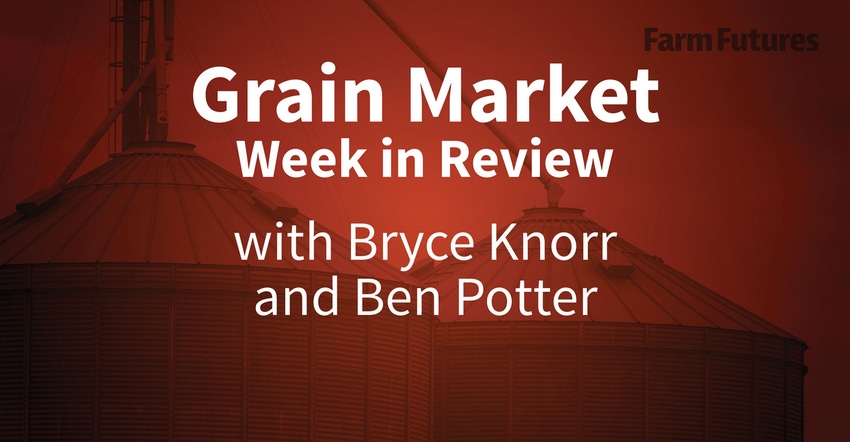May 31, 2019

Need to catch up on market news? From excessive rain to a tariff threat on Mexico, here’s what Bryce Knorr has been analyzing this week.
Morning audio
It didn’t take long for the grain market to react Monday night when trading started after the Memorial Day weekend. Futures gapped higher across the board and held on to most of those gains overnight. With farmers coping with final planting dates for full crop insurance coverage, details of the latest round of tariff aid is just one consideration. Rains could also shut the Mississippi River north of St. Louis into mid-June, further complicating farmers’ marketing decisions.
That rumble you heard this morning wasn’t just thunder. Markets around the world are also stormy. Grain futures shot sharply higher on record planting delays for corn and soybeans, with wet conditions also denting winter wheat conditions. Financial markets are also seeing turbulence, amid fears trade tensions could trigger a recession.
Is the 2019 rally over? Probably not, if history is a guide. Years of extremely slow planting and flooding don’t happen often. But when they do the market’s pattern isn’t the typical “short spike, long tail” seen in drought years. Damage often isn’t known until harvest. So, just like the spring has been a long slog, get ready for a nervous market this summer. Farmers won’t be alone, because investors are just as anxious on Wall Street.
President Trump aimed a new tariff salvo Thursday, sending traders scurrying again for cover in most markets overnight. While grain futures posted modest losses, stocks and crude oil are down sharply on the new tariffs on imports from Mexico aimed at curbing illegal immigration. The move comes as farmers in parts of the Midwest face final planting deadlines today for full crop insurance coverage, just in time for forecasts hinting at drier weather in June.
Feedback from the Field
With most farms getting at least a few open days last week, growers likely recorded their most active week yet according to posts on Feedback From The Field. Farmers said they added 19% more corn acres, which would bring the total to 68% with soybeans advancing 11% to 30%. Farmers normally have around 91% of their corn planted by now with 62% of soybeans in.
Exports
Foreign customers – even reluctant ones like China – showed more interest in U.S. crops last week, as shippers scrambled to deal with flooding on the Mississippi River that restricted supplies to the Gulf. Exporters used every conceivable port to bypass the logjam, including Toledo and harbors on the East Coast.
Tariffs are in the news again today and markets are lower. Today’s news doesn’t involve China, however. The new tariffs looming against Mexican imports target the largest buyer of U.S. corn and wheat this year. Mexico also buys significant quantities of soybeans, ranking third, as the destination of one-in-ten export bushels.
Crop progress
Record slow progress planting corn and soybeans is nothing new for a market trying to figure out just how much flooding could lower production this year. But the impact of heavy rains finally showed up in winter wheat ratings following very heavy storms over parts of Kansas and Oklahoma last week.
Farm aid
The second Market Facilitation Program will allocate funds on a per acre basis, based on the total loss suffered by each county as a whole from an expanded list of crops. USDA presented only the bare outline of the plan last week, and its methodology for allocating aid may not be known for a month or more. Payments won’t begin until farmers certify acreage to the Farm Service Agency by July 15, and processing the claims could take several additional weeks or more. But if the agency uses a scheme similar to the mechanism from MFP-I, it appears the average county payment for crops could run around $47 an acre nationwide.
Market recaps
Grain futures followed other markets lower overnight. While financial markets were already in a downtrend, a threat of new tariffs against imports from Mexico helped stymie the best rallies in month for farmers. President Trump said a 5% tariff would take effect June 10, escalating to 25% if Mexico doesn’t halt the flow of illegal immigrants into the U.S. Mexico is the biggest market for U.S. corn and also buys significant quantities of soybeans and wheat.
Grain futures joined a wave of selling across most markets today, a downturn triggered by President Trump’s threat to slap tariffs on Mexico if it doesn’t half the flow of illegal immigrants across the border. The move against Mexico would put a 5% tariff on imports that would take effect June 10, escalating to 25% in October if Mexico doesn’t seal the border. Mexico is the biggest market for U.S. corn and also buys significant quantities of soybeans and wheat.
Outlooks
Basis outlook - Corn basis many years strengthens in mid-May, when farmers are too busy planting to move grain to town. Farmers aren’t busy in the field this year due to record slow corn planting. But they appear to be taking advantage of the rally to price some of the 2018 bushels still held in storage. Basis weakened in many parts of the Corn Belt as a result.
Fertilizer outlook - With final planting dates for corn already here in some states – and deadlines for full crop insurance coverage passing in others over the next two weeks – the fertilizer industry is coping with problems just as big as those farmers face. While dealers mull what to do with leftover ammonia inventory, they may face the same task soon with urea as attention focuses on UAN for sidedressing. Growers who can look beyond their immediate situation to focus on 2020 should remain in touch for deals.
About the Author(s)
You May Also Like




